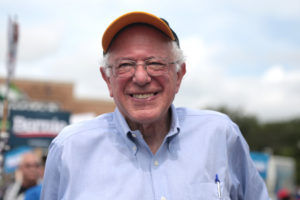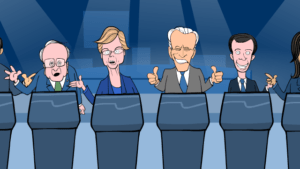Voting Has Started, and ProPublica’s Electionland Project Is on the Case
Much of the country will vote before Election Day. Starting this week, ProPublica's Electionland project has begun looking for problems that prevent people from voting. Vox Efx / Flickr (CC-BY)
Vox Efx / Flickr (CC-BY)
By Derek Willis / ProPublica
Election Day is still a month away, but some Americans are already casting ballots. About 20 states and the District of Columbia have early voting programs, several of which have already begun. It’s estimated that about one-third of the country will have voted by the time polls open on Nov. 8.
The Electionland coalition is also beginning its work. We’ve started looking for problems that prevent eligible voters from exercising their right to cast a ballot before the polls close. Using a combination of social media posts, data about web search trends, and call center records from a coalition of election lawyers, we’ll be looking at the process of voting to help make sure that nobody is shut out because of long lines, improper procedures or inadequate resources.
In a number of states where voters are already casting ballots you will be able to track absentee and early voting via the United States Elections Project, which is headed by Michael McDonald, a University of Florida political science professor. States currently voting include Iowa and Illinois, with North Carolina, Florida and Ohio starting soon.
This past weekend, our partners at the First Draft Coalition trained journalism professors from 13 universities — as well as my colleague Jessica Huseman and me — on social media detection and verification techniques, so that we can more easily find credible information about voting problems across the country. Those professors will, in turn, train about 100 journalism students who will work on Election Day.
Most elections in the United States are well-run, according to experts who study election administration. Even so, there will be problems and when we find acute ones and credible patterns of problems, we’ll pass them along to news organizations that are participating in Electionland for them to act on, ideally while the polls are still open.
More than 300 reporters have signed up to receive tips about voting problems in their areas. If you’re a reporter assigned to cover Election Day, here’s how you can sign up. And if you’re a concerned citizen, you too can help us monitor the vote: Sign up to let us know how your voting experience is where you live.
How and in what locations American citizens vote depend greatly on where they live and on decisions by local and state officials. In many states, early and absentee voting has already begun, but in others voters have fewer options. Some voters will be required under state law to show a specific form of photo ID, while others will not.
That means that what Electionland is looking for depends on the state or county, too. While we’re on the lookout for all kinds of problems with voting, there are specific areas we’ll be focusing on, guided by data from previous elections, changes in election laws and advice from election experts.
Below is a list of some of the problems we’re keeping our eyes out for:
Long lines: In some parts of the country, election-day voters have had to wait more than 30 minutes to vote, longer than recommended by a presidential commission. In this year’s primary elections, this was most vividly seen in Arizona, where a high turnout of non-party-affiliated (and thus partially ineligible) voters in Maricopa County, as well as a reduction in the number of polling locations, contributed to lengthy wait times.
I found Phoenix voter Giselle Aguilar because she’d tweeted about long lines on election day. “I figured it wouldn’t take 30 minutes,” she told me in an email. “No, it was an hour. And my usual polling place was a different church and that was not open.”
Long lines are often merely the visible evidence of deeper problems, from an insufficient supply of voting machines to confusing ballots to poorly trained poll workers.
Polling place location and staffing problems: An insufficient number of voting locations or poll workers can cause a number of problems. If polls aren’t open because the right people haven’t shown up, or if there aren’t enough workers to process the voters that show up on election day, or if a change in voting technology or rules isn’t managed well by administrators, eligible voters can end up not being able to vote. We’ll also be looking for reports of voting locations closing before the official end of voting or while people are still waiting in line.
Changed voting locations: Local election officials move polling locations fairly frequently, for a variety of reasons: population change, a building closes or is under construction, or a newer, larger facility becomes available. But researchers have found that changing polling locations can affect voter turnout. A 2014 study in one Florida county showed that changing polling locations resulted in decreased turnout and disproportionately affected minority voters. Many states offer online lookup tools for voters to find their polling places, but often the official list of such places isn’t set until shortly before Election Day.
Provisional/Affidavit ballot use: Voters who are told they can’t vote on Election Day — because of things like not having a required ID, showing up at the wrong precinct, or not appearing on the official list of registered voters — are supposed to be able to fill out a provisional ballot. Provisional ballots are collected separately and counted later if election officials can confirm the voter’s eligibility. Policies on issuing, accepting or rejecting provisional ballots vary widely between states. A high number of provisional ballots alone isn’t necessarily a sign of something wrong, but it might be.
Enforcement of Voter-ID laws: Since identification requirements for voting are different from state to state (and have been altered by lawsuits and court decisions), there are several ways that voter-ID laws could cause trouble at the polls. Being asked for ID when it isn’t required is one way, as is a voter without the proper ID taking extra poll-worker time to try to prove their identity. For example, South Carolina has a voter-ID law but also an exemption for those who are unable to get an ID due to a “reasonable impediment.” The state election agency in February tweeted incorrect information that voters without ID at the polls would have to bring it later “for your vote to count.” South Carolina voters without ID can sign an affidavit at the polls and have their ballots counted. Poll workers who may not be aware of exemptions or other procedures could prevent someone from voting, or slow the process down and increase wait times.
Deceptive mailers/ads: Leading up to the election, groups trying to influence your vote will be sending out letters or sponsoring ads that refer to the voting process or provide misleading information about voting either before or on Election Day. One example is what are called “vote-shaming” letters, like this one sent to voters in Central Florida before that state’s primary election this year. Another is an email sent to students at George Mason University on Election Day in 2008 falsely announcing that the election had been moved to the following day. If you see or receive deceptive messages like this, we’d like to know about it.
Ballot design problems: Florida’s famous “butterfly ballot” in 2000 is an example of how voters can be confused by the design of a ballot, but it’s not the only one. The number of questions on the ballot, including referenda that sometimes contain lengthy descriptions, can make the voting process longer and cause delays. In most states we’ll get a look at sample ballots before the election, but thanks to local elections, ballots can differ dramatically even within counties.
Hacking: It’s almost impossible for computer hackers, from Russia or anywhere else, to change votes electronically. Voting machines are, for the most part, not connected to the Internet. But it’s comparatively easy to sow chaos by playing to voters’ fears that their votes won’t count. Attempted network breaches at election offices have been reported in Illinois, Arizona and most recently in Florida. We’ll be on the lookout for problems that might be the result of records damaged by hackers, as well as problems caused by voter anxiety.
Voter impersonation: In-person voter fraud is extraordinarily rare in American elections, and there’s substantial evidence that partisan legislatures use the threat of voter impersonation to change voting rules to their own political benefit. But that’s not to say it never happens. If you personally witness somebody voting more than once, or under a name other than their own, we’d like to hear about it, too.
Other problems at the polls: In many states, political party volunteers serve as official election observers, and there are set rules for where they can go and who they can talk to. Official observers can challenge voters who they believe to be ineligible, and in many states they are the only private individuals who may do so. We’re interested in any disruptions to the voting process, whether inside or outside voting locations.
Whether you are a voter interested in sharing your experience at the polls this fall, or a journalist wanting to be a part of the Electionland coalition, find out more about the project and sign up.
Your support matters…Independent journalism is under threat and overshadowed by heavily funded mainstream media.
You can help level the playing field. Become a member.
Your tax-deductible contribution keeps us digging beneath the headlines to give you thought-provoking, investigative reporting and analysis that unearths what's really happening- without compromise.
Give today to support our courageous, independent journalists.






You need to be a supporter to comment.
There are currently no responses to this article.
Be the first to respond.